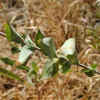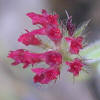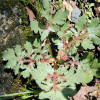
Coarsegold, California
Revised 1-4-09
![]()
.jpg) NOTES
NOTES
Woodland Clarkia
|

Woodland Clarkia, Leaves
|
.jpg) NOTES
NOTES
Crimson Clover
|
|

Unidentified Clover, R02 |
.jpg)
Unidentified Clover, R02
|
.jpg) NOTES
NOTES
Chaparral Honeysuckle,
|
.jpg) NOTES
NOTES
Poison Oak, Fall
|
.jpg) NOTES
NOTES
Scarlet Monkeyflower*
|
.jpg)
Scarlet Monkeyflower*
|
.jpg) NOTES
NOTES
Hollyleaf Redberry
|
.jpg)
Hollyleaf Redberry |
.jpg) NOTES
NOTES
Purple Sanicle
|
.jpg)
Purple Sanicle |

Sea Urchin |
.jpg) NOTES
NOTES
Sea Urchin (Oak Leaf Gall) |
.jpg) NOTES
NOTES
Squawbush, Berries |
.jpg) NOTES
NOTES
Tocolote
|
.jpg)
Tocolote
|
|
.jpg) NOTES
NOTES
Spring Vetch |
.jpg)
Spring Vetch |
.jpg) NOTES
NOTES
Indian Warrior
|
.jpg)
Indian Warrior
|

UID R03 |
 UID W30, Flowers |
 UID W30, Leaves |
 UID W30, Stalks |
NOTES:
Chaparral Honeysuckle
Bloom:
May–July
Description:
Deciduous vine or sprawling shrub with yellow honeysuckle flowers. It has edible but bitter berries. Hummingbirds like the
flowers.
Special:
Native; limited to California.
BACK
Crimson Clover
Bloom: April–AugustDescription: Annual herb, ½–2'. Flower heads are bright red in long cylinders. Leaflets are wedge-shaped.
Special: Not native. BACK
Hollyleaf Redberry
Bloom: SpringDescription: Evergreen shrub to 12'. Flowers are yellow. Berries are bright clear red. Grey bark, stiff branches, upright. Hummingbirds and insects collect nectar from the flowers. Many birds love the berries.
Special: Native. Can cause minor dermatitis. BACK
Indian Warrior
Bloom: January–JuneDescription: Perennial herb. Stalks 4–20". Leaves finely dissected like fern leaves, 4–7", covered with soft brown hairs. Flowering stalks have dense spikes of dark wine-red flowers with a stout straight upper beak & a lower lip of 3 small lobes halfway back on the tube, 1½".
Special: Native. Like all species of Pedicularis, this is a green root-parasite, supplementing its photosynthesis with thievery. Leaves may have been used to make a tea. BACK
Poison Oak
Bloom: April–JuneDescription: Woody shrub or climbing vine, 1–9'. Lobed leaflets in threes (center leaf is long-stalked). Bright green in the early season, reddish later. Flowers are greenish white clusters, forming white berries.
Special: Native. The plant should be avoided in all seasons; its oil causes an irritating dermatitis. BACK
Purple Sanicle
Bloom: March–MayDescription: Perennial herb, ½–2'. Flowers are purple (or yellow) balls with long, feathery stamens. Seeds are round & spiny. Leaf petiole conspicuously broad with spiny margins.
Special: Native. BACK
Scarlet Monkeyflower
Bloom: April–OctoberDescription: Perennial herb. Showy, 2–4'. Hairy & glandular, prostrate or erect, toothed, sticky, & hairy leaves, oblong or ovate, somewhat clasping, in pairs. Three to five palmate veins in leaves. Red flowers are 2", tubular in pairs with 5 lobes, 2 lips. Throat has yellow hairy ridges. Grows in wet areas.
Special: Native. BACK
Sea Urchin (Gall)
Description: Strange shape formed by the Blue Oak in response to the egg laying of nonstinging Cynipid wasps. Eggs may be laid on leaves or other parts of the tree, and the oak responds by forming this particular color and shape of gall, which in turn protects the larva. In fall, the insect chews its way out. BACKSpring Vetch
Bloom:
April–July.
Description: Annual herb, vine, 1–3'. Vine. 1–2
red-purple flowers near the base of each leaf. 4–8 pairs of narrow
leaves are blunt-tipped with tiny bristles.
Special: Not native. Photographed at Oak
Creek.
BACK
Squawbush
Bloom: February–JuneDescription: Deciduous shrub with clumping habit.
Special: Native. Related to Poison Oak, but does not cause rash for most people. Brilliant yellow to red fall color. BACK
Tocolote
Bloom:
May–January
Description:
Annual herb, 1–5'. Yellow flower heads (½–¾"), with long spines (½")
below. Cottony-haired leaves linear, extending down the stem. Well branched.
Special:
Not native. Very similar to Yellow Star Thistle.
BACK
Woodland Clarkia
Bloom: May–JuneDescription: Annual herb, 1–3'. Pink outer petal lobe with a darker red spot, rectangular to round on a threadlike base. 8 anthers.
Special: Native; limited to California. BACK